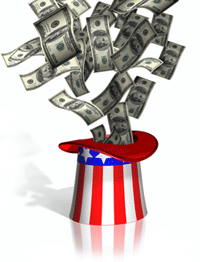 Back in 2009, tax credits for energy efficiency upgrades were enacted as part of the American Recovery and Reinvestment Act. These tax credits motivated Americans across the country to replace old, inefficient equipment with new high-efficiency HVAC systems, with consumers taking advantage of $290.7 billion in tax credits. The credits expired at the end of 2011, but Congress has reinstated them as part of the "fiscal cliff" agreement of January 2013. Learn the terms of the tax credits for energy efficiency upgrades, and how to qualify.
Back in 2009, tax credits for energy efficiency upgrades were enacted as part of the American Recovery and Reinvestment Act. These tax credits motivated Americans across the country to replace old, inefficient equipment with new high-efficiency HVAC systems, with consumers taking advantage of $290.7 billion in tax credits. The credits expired at the end of 2011, but Congress has reinstated them as part of the "fiscal cliff" agreement of January 2013. Learn the terms of the tax credits for energy efficiency upgrades, and how to qualify.
General tax credit terms
- To qualify for the credits, homeowners must install any new HVAC equipment or energy-efficiency upgrades by Dec. 31, 2013.
- Qualified upgrades during 2012 qualify retroactively for the tax credits, if they meet the criteria outlined below, and homeowners hold on to the appropriate receipts.
- Only equipment installed in newly built or existing primary homes qualifies; homeowners cannot claim equipment installed in secondary or vacation homes.
- The tax credit has a lifetime cap of $500. If you previously claimed a credit under this tax benefit, you’re limited to the remaining amount available. However, you can combine tax credits to reach that $500 cap.
Items covered under the tax credits
Here are minimum efficiency ratings that equipment must achieve in order for a homeowner to qualify for the credit.
- Furnaces and boilers earn $150 when their Annual Fuel Utilization Efficiency (AFUE) rating is at least 95 percent.
- Air-source heat pumps earn $300 with a minimum Heating Seasonal Performance Factor (HSPF) of 8.5 and a Seasonal Energy Efficiency Ratio (SEER) of 15.
- Central air conditioning earns $300 when the SEER rating starts at 16.
- Water heaters also earn $300. Heat-pump water heaters must have a minimum Energy Factor (EF) of 2.0, while systems fueled by oil, natural gas or propane must have an EF of 0.82.
- Insulation, windows, exterior doors and roofing, materials that improve the home’s efficiency, may qualify for tax credits, capped at 10 percent of its cost. Talk to your HVAC professional before selecting materials to ensure they meet the program’s criteria.
For more information about available tax credits for energy efficiency upgrades, contact Hartman Brothers Heating & Air Conditioning, Inc. today. We've served the Fort Wayne area as a family-owned and operated company since 1963.
Our goal is to help educate our customers in New Haven, Indiana and surrounding Fort Wayne area about energy and home comfort issues (specific to HVAC systems). For more information about Tax Credits and other HVAC topics, download our free Home Comfort Resource guide.
Image courtesy of Shutterstock
